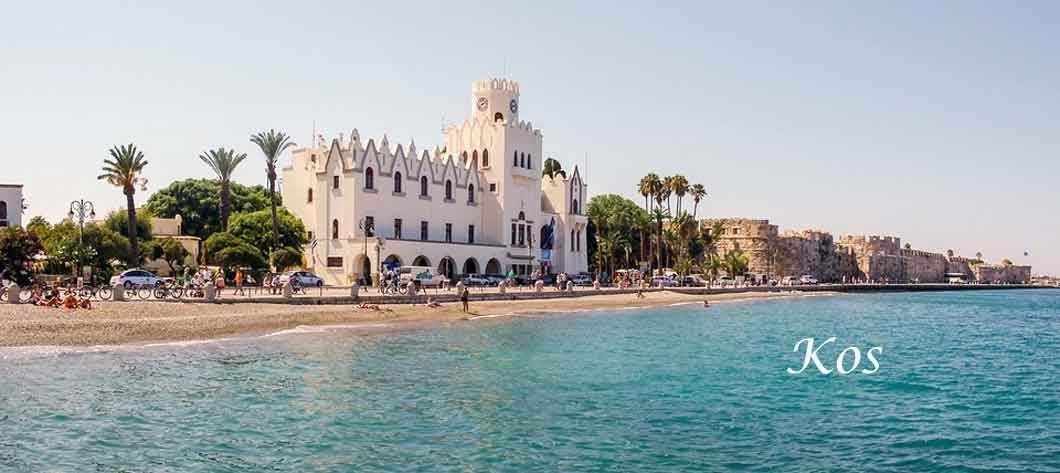Information about the island of Kos
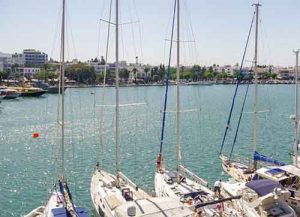
The island has been quite rich ever since ancient times, with the exception of times of enslavement under the Turks and several pirate attacks. The fertile soil have blessed the locals with grapes for wine, wheat, fruits and olives as well as obsidian and rich fishing waters.
Kos is the second biggest island in the archipelago after Rhodes and can give its larger neighbour a run for its money when it comes to attracting the tourist hordes. The island has 290 kilometres of coastline with a wealth of wonderful beaches – most which are smothered with cheek-by-jowl sun shades in July and August.
A rich combination of sandy beaches and some impressive sightseeing gives Kos a broad holiday appeal and this is one of the most popular beach holiday destinations in the Greek Islands.
Kos Town is a heady mix of ancient and modern where dance clubs jostle with impressive ancient monuments whilst the rest of Kos boasts a varied landscape of mountains and plains.
Kos has been a popular beach holiday island for many years and package holiday hotels line much of the east coast around Kos Town.
There is a sprinkling of pleasant beach resorts along the flat north coast but the main holiday area of Kos lies to the south-west at the party clubbing resort of Kardamena and along the sands around Kamari Bay.A string of deep sandy beaches between both resorts attracts big holiday crowds throughout the summer.
Despite the thousands of holidaymakers that pour into the island each year Kos still has lots of open space and even the large scale hotel complexes are comfortably spread out, especially along the fast developing north coast. For an all-inclusive hotel holiday with a good beach there is little to compare with Kos in all the Greek islands.
Kos is also good for organised boat excursions where local volcanic islets and the mainland coast of Turkey provide most popular targets. Inland excursions are fully booked too, especially to Greek Nights in the mountain villages.
Kos Town is still picturesque and pleasant town, despite some drab modern buildings and the huge crowds that throng the streets. Neatly arrayed roads and wide tree-lined avenues converge on attractive, shady squares where café tables are set out in the sun.
Ancient ruins lie scattered across Kos town and are considered among some of the best archaeological sites in the Mediterranean
Kos is an island of big resort complexes and frantic beach parties. But it’s also the birthplace of Hippocrates, the Father of Modern Medicine, and home to the western world’s first ever medical school. History and archaeology buffs will delight in its treasure trove of fascinating ancient sites.
Huge numbers of international visitors – mostly British, Dutch and Scandinavians – arriving on the island in the summer months, the vast majority spend the day swimming and sunbathing on the beaches by day and serious partying after the sun goes down.
The discerning tourist though, will dig deeper to find an island steeped in history, a land of castles and temples from antiquity, a place where traditional unspoilt villages cling to the craggy slopes of pine-clad mountains. Look hard enough and you’ll even be able to find a quiet bit of beach even at the height of the season.
Mythology
According to Greek mythology, Kos was named after the daughter of Asclepius – the god of medicine – who was known as “Cos” or “Coeus”. Legend has it that Asclepius fell in love with a mortal woman named Phaethusa while visiting Kos. Together they had four children, including Kos who inherited her father’s healing abilities.
Asclepius built his sanctuary on the island to honor his daughter and her powers. This sanctuary became famous for its healing rituals where people would come from far and wide seeking cures for their ailments. Even today, remnants of this sanctuary can be found on the island in the form of ancient ruins.
Aside from its connection to Asclepius, there are other myths surrounding Kos Island that have captured people’s imagination throughout history. One such tale revolves around Hercules – son of Zeus – who sailed to Kos after completing one of his labours. He was welcomed by King Alcinous who offered him hospitality in exchange for help against an invading army.
History
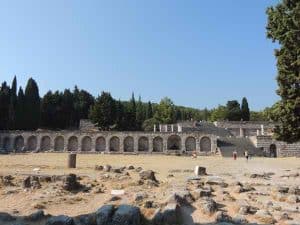
Archaeological evidence suggests that Kos has been inhabited since the Neolithic era. The island flourished during the Minoan and Mycenaean periods, becoming an important center in the ancient Greek world. It was known for its fertile lands, strategic maritime position, and as a hub of trade and cultural exchange.
In the classical period, Kos became famous as the birthplace of Hippocrates, the “Father of Medicine,” in the 5th century BCE. The island was a member of the Delian League and later played a role in the Hellenistic era following the conquests of Alexander the Great. During this time, Kos enjoyed prosperity and cultural achievements, including advancements in medicine and the arts.
Under Roman rule, Kos continued to thrive, benefiting from the Pax Romana. It became known for its schools of medicine and philosophy. With the division of the Roman Empire, Kos became part of the Eastern Roman (Byzantine) Empire, experiencing both flourishing periods and challenges, including pirate raids and earthquakes.
During the Middle Ages, Kos faced invasions and dominion by various powers, including the Knights of St. John in the 14th century, who fortified the island against Ottoman threats. The Knights left an architectural legacy that includes the Castle of Neratzia at the harbour of Kos Town.
The Ottoman Empire captured Kos in the 16th century, marking a period of cultural and demographic changes. The island remained under Ottoman control until the early 20th century, except for a brief period of Russian occupation. In 1912, it was occupied by Italy, which invested in archaeological excavations and infrastructure improvements, leaving a distinct architectural imprint on the island.
After World War II, Kos was briefly under British administration before being integrated into Greece in 1947 as part of the Dodecanese islands.
Architecture of Kos
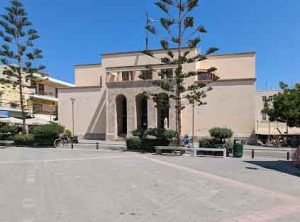
It was divided into three residential zones according to class criteria: the northern, the central and the eastern. The northern sector is divided into small houses, for the popular strata of the city (case popolari). The central part consisted primarily of two-story houses with ground-floor shops, in which the members of the bourgeoisie (palazzine) lived. Finally, in the eastern zone mansions were built in gardens for the Italian settlers (villini). Other elements of the Italian influence are the extensive green zones in the city, which also include tropical plants, as well as the characteristic public buildings designed by Italian architects and located both in the city and in the settlements of Antimachia and Kardamena.
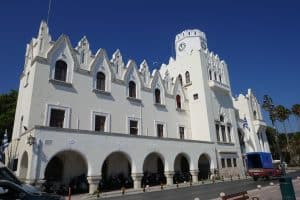
We find it mainly in the villages of Asfendiou, Pili, Kefalos and Antimachia, where the low and wide-fronted detached houses, with a parallelogram shape, simple masonry and a flat roof, some stone and some not, are painted white and have windows and doors painted in bright colors. The interior of the house is, as in the rest of the Dodecanese, particularly well-kept, responding to the functional needs of the farming family. Noteworthy is the long wall, the canoe wall or gano wall as it is called, on which hung plates, frames, the house mirror and other necessary items that covered the basic needs of the house. In many parts of the island, the traditional windmills are also characteristic, with the most characteristic one of Antimachia. There are also many narrow, cobbled streets.
What to See in Kos
The Archaeological Museum of Kos

In the ground floor area of the archaeological museum and in the atrium, the most important works of sculpture are exhibited, as well as mosaics.
In the western hall, statues from the Hellenistic era are exhibited, most of which were found preserved in the galleries of the Conservatory.
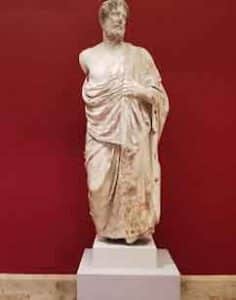
In the northern hall there are statues of Demeter, Koris and Athena (mid 4th – mid 3rd century BC).
In the same room are exhibited Hellenistic statues of Aphrodite, the Nymphs, Tyche, (1st century BC) etc. Statues from the Roman period are displayed in the eastern hall, among them a seated Hermes and Demeter.
Finally, one more mosaic, from the Hellenistic era, with a representation of the seabed, adorns the northern wall of the peristyle and comes from the restored Roman House
Castle of Neratzia
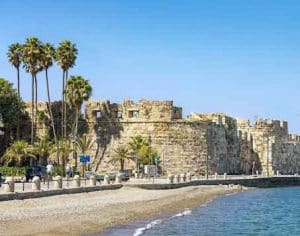
In the 19th century, the Castle of Nerantzia was used as a barracks for the Turkish garrison and the residence of the Turkish commander. On March 17, 1816, a powder magazine accidentally exploded and destroyed a large part of the castle.
Its current form is due to the Italian Archaeological Service which, during the Italian occupation, demolished the Turkish additions and proceeded with extensive works to restore the castle to its original form.
During the German occupation, the castle was garrisoned by the garrison and functioned as a prison. It was declared a historical monument in 1948.
Castle of Antimachia
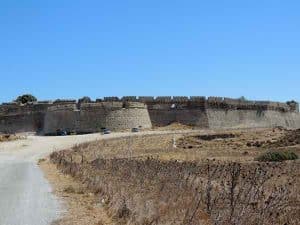
Built in Venetians times it passed into hands of the Order of the Knights of St John and consists of the castle ruins and two old churches. There is a good road to the castle which is not too far from the popular resorts of Kefalos and Kardamena.
It looks more impressive outside than in as the inner area is very shabby and in a poor condition. There is not much to see inside apart from two Venetian churches, Agios Nikolaos dates from the 16th century and Agia Paraskevi was built in early 18th century but there are good views of the surrounding area.
The plane of Hippocrates
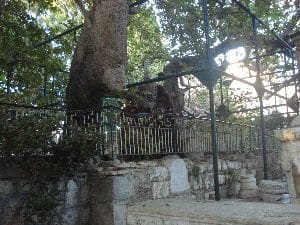
The plane tree of Hippocrates is located in Square of Platanos, in front of the Castle of the Knights and the Governorate and next to the Gazi Hassan Mosque, in the center of Kos town.
The current tree is about 500 years old and is likely a descendant of the original tree that stood there at the time of Hippocrates. The diameter of its trunk is 10 meters and the peripheral ring is up to 15 cm thick.
Some of its branches are supported by metal scaffolding to prevent them from breaking due to their weight and the forces of the wind. Next to the tree are two Ottoman fountains, the water of which, according to their inscription, comes from the fountain of Hippocrates.
The ancient agora of Kos
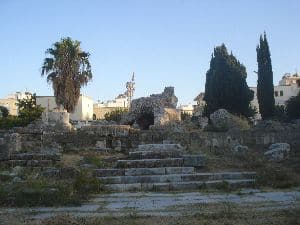
In this zone, apart from the visible part of the market, part of the city’s fortifications, the sanctuaries of Aphrodite and Hercules, building islands with the remains of private houses, and also part of the ancient port of the city are visible.
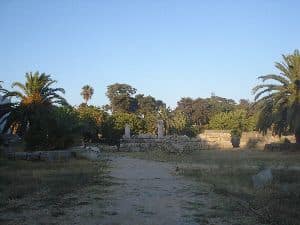
The excavation of the Greek archaeological service on the south side determined the length of the building to be approximately 300 meters. Further east from the ancient market, the excavations discovered part of the city’s urban plan with wide streets, buildings, houses and shops.
The largest part of the ancient market is buried under the modern city. In fact, its southern part came to light with recent excavations opposite the altar of Dionysus, which led to the restoration of two columns that belong to the ancient market.
Τhe Roman Villa
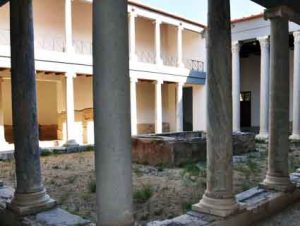
In 1933, the great earthquake almost completely destroyed Kos. The Italians, who then occupied the island, found the opportunity to proceed with urban planning and carried out extensive excavations, as they knew that ancient monuments were hidden under the flattened buildings.
The Italian archaeologist Laurenzi undertook the excavation and then the Italian Administration proceeded with the complete restoration of the house, which was completed by 1940.
Asklepion of Kos
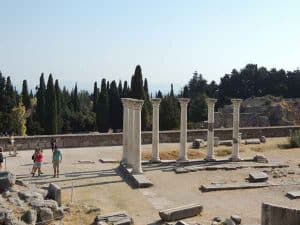
It dates back to the Hellenistic era, a point of view that is reinforced by the exploitation of the space presented by the three consecutive levels – an element of oriental architecture that entered Greek architecture with the conquests of Alexander the Great.
It is built on the slopes of a hill with lush vegetation and a view of the sea and the Asia Minor coast. It is the most important archaeological monument of the island of Kos.
In ancient times it was a place of worship of the god Asklepios and a place of healing and teaching of Medicine. Hippocrates, one of the most important representatives of medicine in antiquity, taught there in the school he had founded on the site of the Asklepieion. In contrast to the sanctuary of Asclepius in Epidaurus, scientific medicine was especially developed in Kos.
What to do
Kos Island offers a diverse array of activities for visitors to enjoy, catering to a wide range of interests and preferences. From exploring ancient ruins to relaxing on pristine beaches, there’s something for everyone on this enchanting Greek island.
Visitors can immerse themselves in the island’s rich history by visiting landmarks such as the Asklepieion, the ancient healing sanctuary dedicated to Asclepius, and the Castle of the Knights, a medieval fortress that offers panoramic views of the island.
For those seeking adventure, Kos offers opportunities for hiking, cycling, and exploring its scenic countryside. The island’s rugged terrain and picturesque landscapes provide the perfect backdrop for outdoor activities and exploration.
Water sports enthusiasts will find plenty to keep them entertained, with options including snorkeling, scuba diving, windsurfing, and sailing. The crystal-clear waters surrounding Kos are teeming with marine life, making them ideal for underwater exploration.
Food lovers can indulge in the island’s vibrant culinary scene, sampling traditional Greek dishes at local tavernas and restaurants. From freshly caught seafood to mouthwatering mezes, Kos offers a tantalizing array of flavors and culinary delights.
Those in search of relaxation can unwind on one of Kos’s many beautiful beaches, soaking up the Mediterranean sun and taking in the stunning coastal scenery. With its soft golden sands and turquoise waters, Kos’s beaches are the perfect place to escape the hustle and bustle of everyday life.
Finally, visitors can explore the island’s charming villages, where they can stroll through narrow cobblestone streets, admire whitewashed buildings adorned with colorful bougainvillea, and immerse themselves in the laid-back island lifestyle.
Whether you’re a history buff, an adventure seeker, a foodie, or simply looking to relax and unwind, Kos Island offers an unforgettable experience that will leave you longing to return again and again.
Kos villages
Kefalos
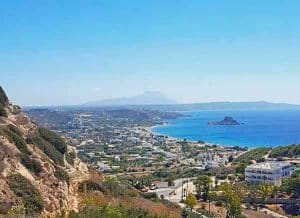
Kefalos is the most remote village of Kos. Built on a hill, it is particularly picturesque with its narrow streets and its view of the gulf of Kefalos and the islet of Kastri.
It is located on the site of the old capital of the island, Astypalaia. It got its name either from the shape of the area that looks like a vulture’s head, or because it was a capital village in ancient times.
In Kefalos, the visitor has the feeling that the sea breeze mixes with the mountain air. It is no coincidence that this part of Kos has the best climate. The area of Kefalos has beaches that cover all tastes, some of them are cosmopolitan and others ideal for isolation.
For your stay in Kefalos, you will find hotels and rooms for rent, while in the traditional taverns of the area you will try the local cuisine.
Mastichari
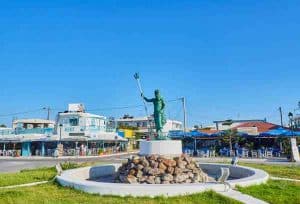
Mastichari has developed in recent years into a modern tourist resort. It is famous for its fresh fish and in its fish taverns, located a breath away from the sea, you will enjoy traditional seafood recipes.
Choosing Mastichari as a place of residence, one has the possibility to visit the neighbouring island of Kalymnos, with which Mastichari is connected by daily routes. Mastichari is also very close to Kos airport.
For your stay you will find hotels, rooms to rent and apartments. It is a quiet village, ideal for those who, on their holidays, seek tranquillity.
Asfendiou
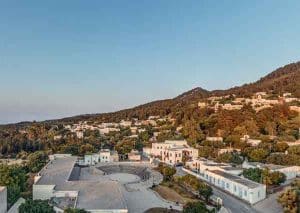
It is built among olives, myrtles, cypresses, pines and laurels. It is divided into the neighborhoods of Evangelistria or Pera Geitonia and Asomatos.
At a distance of 1.5 km from the village of Asfendiou is the tiny village of Zia, with a wonderful view and one of the most beautiful sunsets in Kos.
Agios Fokas
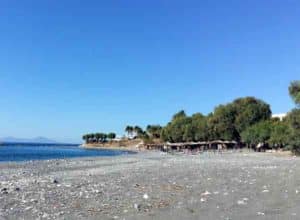
Many hotel complexes are located along the distance that separates it from Kos town.
The options here for accommodation and food are many.
Hotels of all categories, rooms for rent, traditional taverns but also luxurious restaurants offering international culinary tastes.
Antimachia
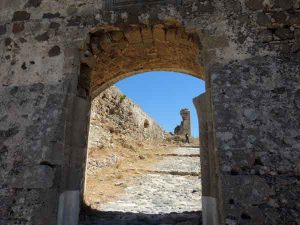
It is located almost in the centre of the island of Kos and is 23 km from the town of Kos. The inhabitants of Antimachia are music lovers and are famous for their talented instrumentalists in traditional Greek music.
The people of the area have an artistic vein, as apart from music, they are distinguished for their ability to create lyrics, even satirical ones. Antimachia therefore offers the visitor a journey through time through its cultural events and attractions. For your stay in this special village of Kos, there are hotels, rooms for rent and apartments that will offer you excellent services.
Kardamena
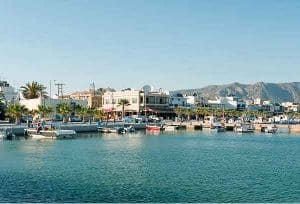
The small picturesque town is a main tourist resort of Kos that has evolved in recent years into a modern tourist resort. This village of Kos never sleeps!
It is, as the locals say, not without reason, the “nightlife” of Kos, since the nightlife here is intense and caters for all tastes.
Built almost on the sea, Kardamena has the air of the sea breeze. Your options for accommodation are many. There are hotels, rooms for rent, furnished apartments and bungalows.
Marmari
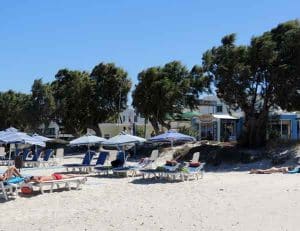
It belongs to the areas of Kos that have an intense night life. The ecological consciousness of its inhabitants has made it a model of tourist development. The hotels are located 1 km away from the beach.
In Marmari you will find large hotels as well as rooms for rent of all categories. As far as your night entertainment is concerned, Marmari is the ideal destination for those who on their holidays want to go all night long.
Pyli
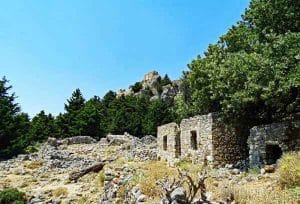
A walk to Peli, as it was called in ancient times, will take you back in time and enchant you with the beauty of the place, still unadulterated by mass tourism.
All you have to do is get lost in the alleyways with the stone-built houses that surround the picturesque square with its traditional cafes and small, family-run tavernas.
The Pyli House deserves your attention, an old house whose spaces have been designed to faithfully represent the hall, kitchen and bedroom of traditional houses.
Tigaki
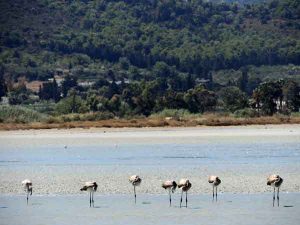
Tigaki is the closest settlement to the town of Kos. It is in an advantageous position since the archaeological sights of Kos are located a short distance from it.
It has a large stretch of sandy beach and offers the visitor all the tourist facilities. Today, Tigaki has developed into an autonomous tourist area with hotels, rooms and apartments for rent, taverns, restaurants, bars and cafes offering high quality accommodation.
Beaches
Kos beaches are not only places of natural beauty but also hubs of activity and culture, offering visitors a chance to experience the island’s vibrant life, indulge in local cuisine at beachfront tavernas, and enjoy the plethora of water-based activities available. From secluded coves to bustling beach bars, Kos’ coastline promises an unforgettable seaside experience to all who visit.
The most popular beach on Kos is Paradise beach, a long, beautiful sandy beach. There are sun beds, water sports and is a good place for families with children. Other popular beaches are Tagaki, Mastihari, Lambi and also the beaches in Kardamena and Kefalos, which most surfers prefer. If you want to find a quiet beach it is best to look around on the west side.
Nightlife
Kos’ nightlife is diverse, vibrant, and welcoming, making it a perfect destination for those looking to experience the joyous and spirited side of Greek island life. Whether you’re looking for a night of dancing, a quiet evening under the stars, or a cultural experience, Kos has something to offer for every night owl.
The island caters to a wide range of tastes and preferences, making it a popular destination for travelers seeking fun after the sun sets. From quaint tavernas offering traditional Greek music and dance to modern clubs and beach bars playing the latest hits, Kos promises an unforgettable night out for everyone.
The heart of Kos’ nightlife beats in Kos Town, where a plethora of bars, clubs, and cafes line the streets, offering a mix of international and local music. The harbor area, in particular, transforms into a bustling hub of activity at night, with people from all over the world gathering to enjoy cocktails, dance, and socialize. For those looking for a more relaxed evening, there are numerous venues along the coastline and in the villages where you can enjoy a serene atmosphere, stunning views, and the gentle sound of the sea.
Bar Street is another hotspot for night owls, featuring a range of bars and clubs that cater to various music tastes and party vibes. Whether you’re into electronic dance music, rock, or pop, you’ll find a place that suits your mood. Additionally, the island hosts several open-air nightclubs, allowing party-goers to dance under the stars until the early hours of the morning.
For a taste of traditional Greek entertainment, don’t miss the opportunity to visit one of the local tavernas where live Greek music and dance performances offer a cultural experience unlike any other. Here, you can immerse yourself in the local culture, savour delicious Greek cuisine, and even join in the dancing.
Local Cuisine
The local specialty is cheese baked with red wine called “Red Cheese”. There is a wide range of taverns and restaurants, and you can get Greek as well as international food. Most places are in Kos town, but you’ll also find many little taverns in the villages, as well as on several beaches.
Kos cuisine offers a delicious blend of traditional Greek tastes with influences from across the Aegean and beyond. Most of its products are from the island’s fertile lands and bountiful seas, featuring a wealth of folive oil of the highest quality, and seafood caught in its clear blue waters. In Kos, the culinary experience is about more than just sustenance; it’s a gateway to understanding the local culture and the island’s connection to the rhythms of nature.
Meals are often leisurely affairs, intended to be savoured with family and friends against the backdrop of the island’s stunning natural beauty. From the simplicity of a dish of freshly caught fish drizzled with lemon juice and olive oil to the complex layers of flavours in a traditional casserole, the food of Kos is a celebration of both the island’s heritage and its present-day melding of influences.
As you explore Kos, you’ll find that its tavernas, restaurants, and markets are not just places to eat but are the beating heart of the community, where the island’s spirit of hospitality and love for life are palpable. This cuisine, rich in flavours and steeped in history, offers a delectable journey through the essence of Kos and the wider Mediterranean region.
Shopping
Because it is such a popular island, you’ll be able to find all kinds of shops on Kos, especially in the town. Jewellery, ceramics, leather belts, sandals, clothes, textiles, embroideries, copies of ancient artworks, paintings, icons, local wine, honey and things for the beach and much, much more. A nice place to visit is the public market just before the entrance to the archaeological site. Around the square there are several public buildings with wonderful architecture and many nice cafeterias.
Where to stay
Such a popular holiday island offers a wide range of holiday accommodation, from luxury hotels to cheap family-run rooms. It’s not a good idea to turn up on spec in the high summer as many hotels are block booked.
Kos Town which has a large number of small family-run hotels and many offer excellent value as they try to undercut the big hotels. Almost every street around the harbour has small hotels that offer cheap rooms.
There are no campsites on Kos nor any youth hostels either which is strange for such a popular holiday island.
The north coast beach resorts cater mainly for the package holiday market but smaller hotels and apartments can be found, especially in the beach resort of Mastichari which also has a small port with ferries to Pserimos and Kalymnos.
In the south, Kardamena is packed with hotels and apartments but high demand tends to push up prices. Kefalos Bay, further west, is cheaper and many small apartments can be found on the hillsides above Kefalos village.
When to go to Kos
Deciding on the perfect time to visit Kos, a gem nestled in the Aegean Sea, hinges on what you seek from your Greek island getaway. Renowned for its balmy Mediterranean climate, the island caters to a wide array of preferences, from those desiring the vibrant buzz of peak season to others seeking the serene beauty of its less crowded periods.
The high season, spanning July through August, sees Kos at its most lively. The island pulses with energy as tourists from around the globe converge to bask under the radiant sun. Beaches, renowned for their crystal-clear waters and golden sands, teem with sun-seekers, while the streets of Kos Town and other picturesque villages are abuzz with a festive atmosphere. This period is ideal for those who revel in the warmth of summer and are eager to partake in the island’s abundant nightlife, from beach bars to bustling clubs. The Aegean Sea, at its warmest, offers perfect conditions for swimming, snorkeling, and water sports. However, it’s worth noting that with popularity comes a spike in accommodation prices and crowded locales.
The shoulder seasons, April to June and September to October, present a different facet of Kos. The temperatures, milder yet sufficiently warm for beach outings, create ideal conditions for outdoor activities such as hiking, cycling, and exploration of the island’s rich historical sites without the summer’s scorching heat. The landscape is vibrant, with spring bringing a burst of wildflowers, adding a splash of color to the ancient ruins and the countryside. September retains much of the summer’s warmth, allowing for pleasant swimming while offering a more relaxed atmosphere as the tourist tide ebbs. Accommodations are easier to come by during these months, often at reduced rates compared to the peak season.
Winter, from November through March, marks the off-season in Kos. The island quiets down, and while many tourist facilities close, a serene beauty envelopes the landscape. The cooler temperatures and occasional rain showers transform the island, offering a unique perspective on its natural beauty and ancient ruins, free from the throngs of tourists. This period is perfect for those who prioritize tranquillity and are interested in experiencing the local way of life. Additionally, it’s an opportune time for bird watching, especially in the wetlands and salt pans near Tigaki, which attract migratory birds.
For cultural enthusiasts, timing a visit to coincide with local festivals can enrich the travel experience. Easter in Kos, offers a glimpse into Greek traditions, with processions, feasts, and fireworks. The feast day of Saint John, the patron saint of Kos, in August, is marked by festivities in the town of Kefalos, providing insight into the island’s spiritual life and community spirit.
Ultimately, the best time to visit Kos depends on your personal preferences. Whether it’s the lively pulse of the high season, the gentle warmth of the shoulder months, or the quietude of winter, Kos extends a timeless invitation to explore its shores, history, and culture at a pace that suits you.
Getting around Kos
Roads on Kos are reasonably good between the main resorts. A couple of tourist trains run in Kos Town. The green one does a round trip of Kos Town and a blue train heads for the nearby ruins at Asklepieion.
The DEAS bus company run routes in Kos Town while KTEL Buses operates further afield and service schedules are on the KTEL Kos website.
Most buses run from the south side of the harbour while KTEL is based on Kleopatras, just north of the centre. There are 10 buses daily to Tingaki, six to Kefalos via Paradise beaches, five to Mastichari and Pyli with three daily to Zia.
Town buses leave every 30 minutes s to Psalidi and to Agios Fokas, Mesaria and Platani. Times are posted at the harbour and the bus station.
Taxis are plentiful and found at the harbour area, beneath the minaret, or across from the castle. Taxis fares are fixed (see Greek info pages) but check the price before getting in. It costs extra to pre-book from a hotel.
Cycling is very popular on Kos. It’s flat and there are dedicated cycle lanes. With around 4,000 cycles for hire on Kos but beware; they look alike so it’s a good idea to mark yours with a coloured ribbon or something.
The Tourist Train
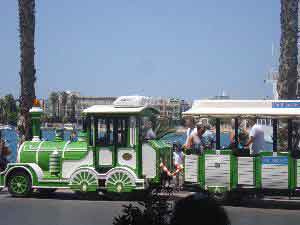
Its starting point is at the beach front of the port of Kos just at the road that goes along the walls of the Venetian Castle.
The green roller coaster will take you around the city.
Its route takes about 20 minutes and its starting point is the town hall in the center of the city.
A ride on the roller coasters will give you the opportunity to see the most important sights of the city.
How to get to Kos
By air
The island is well connected with all the other islands in the Dodecanese and with the Greek mainland. There are regular Olympic Airways flights to and from Athens and direct air links with the UK and other European destinations. Piraeus is 12-15 hours by ferry and Rhodes, the Dodecanese capital 92 kilometres south east of Kos, is 3.5 hours. Regular hydrofoils and catamarans connect the island with the other main islands in the group and with Samos in the North Eastern Aegean.
Kos Airport is in the centre of the island between Mastichari in the north and Kardamena to the south, and some 26 kilometres west of the capital port at Kos Town.
As well as summer charters there are daily scheduled domestic flights to Athens and to Rhodes. Cheap airlines like EasyJet and Ryanair also offer direct flights to Kos.
The Airport, or Kos, has 12 check-in desks and three baggage belts but expect queues in the high summer season.
With annual passenger numbers of more than two million the airport opens 24 hours in the summer to cope with the holiday traffic.
The airport is not particularly well equipped. It has a restaurant, a health centre, some shops and a cafe/bar but not much else and there are no hotels nearby. There is parking for about 200 cars.
Public buses run to Kos Town via Mastichari and Marmari and there are services to resorts at Kardamena and Kefalos.
Taxis are a cheap way to reach nearby resorts like Kardamena and Mastichari but its expensive to Kos Town.
By ferry
Kos Town lies on main Dodecanese ferry route which runs from Rhodes – Kos – Kalymnos – Leros – Lipsi – Patmos with several ferries each day. There are sailings to islands in the Cyclades throughout the summer. The north coast port of Mastichari operates routes to Kalymnos.
The harbour at Kos Town is packed with ferry agents and travel offices with offers of scheduled services, boat trips and day excursions with daily trips to Bodrum in Turkey very popular along with excursions to nearby islets at Pserimos, Plati, Nisyros and Giali.
